13.2 Cézanne: the Modernist Patriarch
Paul Cézanne was an original Impressionist, having contributed to the 1st Salon des Refusés showing. By the early 1880s, Cézanne had retreated to his hometown of Aix-en-Provence to live a quiet life, financed by his father’s upper middle-class resources. Unworried by any need for patrons, he simply painted until his death in 1906.
To the painters of the next generation, Cézanne was the pioneer who pointed the way forward. What do you see in his Landscapes? How is he handling Shape and Color? How is Form emerging into the foreground of our awareness?
 |
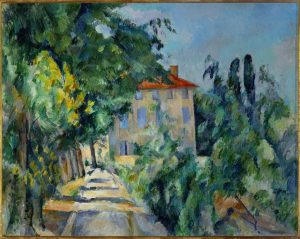 |
| House with a Red Roof. (c 1890). Oil on canvas. | The Bay of Marseille, Seen from L’Estaque (1880-1890). Oil on canvas. |
Cézanne is known for painting repeated versions of a given subject. He did this not, as Monet had done, to capture the subject in different visual conditions, but as repeated efforts to solve the puzzle of a particular Composition. Almost obsessively self-critical, he kept feeling that he was missing the solution, often leaving a painting unfinished. Here are two of his attempts to capture a group composition of bathers.
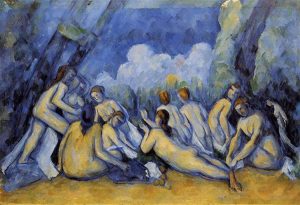 |
 |
| Les Grandes Baigneuses (Large Bathers). (1906). Oil on canvas. | Bathers. (1906). Oil on canvas. |
In the Large Bathers composition, compare the Formal qualities of the bathers to the other visual elements. How do the women’s vaguely modeled Organic Forms blend with and parallel the background lines and shapes?
Now consider the other version of the scene. Are the trees a bit more naturalistic? But what has happened to the figures of the women? Clearly, some are not completed. But taking the composition as it stands, how are sheer Media, paint and canvas, emerging out of the responsibility for Representation? How do we react to pure Aesthetic Form?
Mont Sainte-Victoire rose above Cézanne’s home, and he painted it many times. He kept trying to solve the puzzle of composing the depth of the landscape without resorting to traditional Linear Perspective. On the one hand, Cézanne had a strong sense of the depth of Virtual Space. On the other, however, he increasingly emphasized blocks of color and shape, the components of the illusion of the subject. Cézanne strove for a precarious balance between the “true” vision of the scene and his interest in those chunks of sheer Form.
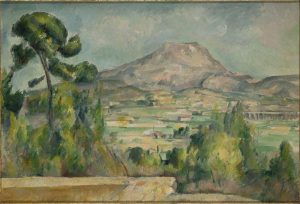 |
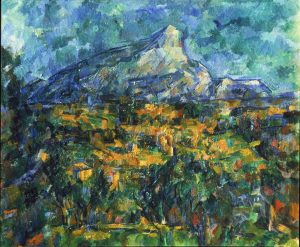 |
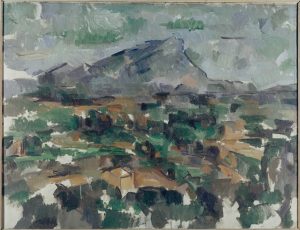 |
| Mont Sainte-Victoire. (1890). Oil on canvas. | Landscape at Mount Sainte-Victoire. (1905). Oil on canvas. | Mont Sainte-Victoire Seen from Les Lauves. (1906). Oil on canvas. |
The result is a fragmentation of the Renaissance concept of a painting as a window on the world. Cézanne’s idea of seeking the truth of a scene is analytical: he perceives in all visual subjects a small number of component geometrical shapes. In a letter to his friend, the painter Émile Bernard, Cézanne encourages the pursuit of spheres and cones, his idea of the universal components of nature.
Deal with nature by means of the Cylinder, the sphere and the cone, all placed in perspective, so that each side of an object or a plane is directed towards a central point. Lines parallel to the horizon give breadth, a section of nature or, if you prefer, of the spectacle spread before our eyes.
from Letter to Émile Bernard, April 15, 1904.
Cézanne’s ideas and practice would have enormous influence on the artists of the new century. He remained committed to the task of painting “nature,” but he also deconstructed the Representational spell and began to direct viewers’ attentions toward Formal elements of the composition. Out of this emerging interest in Color, Form, and Medium would grow Modern art, increasingly liberated from the Mimetic task. In this work by Kazimir Malevich, we can clearly see the influence of Cézanne’s notion that visual subjects are composed of spheres and cones.
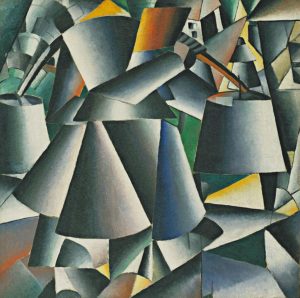 |
| Kazimir Malevich. (1913). Woman with Pails: Dynamic Arrangement. Oil on canvas. |
References
Cézanne, P. (1906). Bathers. [Painting]. Private collection. WikiArt https://www.wikiart.org/en/paul-cezanne/bathers-2
Cézanne, P. (1880-1890). Bay of Marseille, Seen from L’Estaque [Painting]. Chicago, IL: The Art Institute of Chicago. ID G28187. https://www.artic.edu/artworks/16487/the-bay-of-marseille-seen-from-l-estaque
Cézanne, P. (1906). Les Grandes Baigneuses (Large Bathers) [Painting]. London, UK: The National Gallery. NG6359. https://www.nationalgallery.org.uk/paintings/paul-cezanne-bathers-les-grandes-baigneuses
Cézanne, P. (c 1890). House with a Red Roof [Painting]. Private collection. WikiArt https://www.wikiart.org/en/paul-cezanne/house-with-red-roof-1890
Cézanne, P. (1905). Landscape at Mount Sainte-Victoire [Painting]. Moscow, RU: Pushkin Museum of Fine Arts. https://collection.pushkinmuseum.art/en/entity/OBJECT/78278?query=Cezanne&index=10
Cézanne, P. (April 15, 1904). Letter to Émile Bernard. Obelisk. https://www.arthistoryproject.com/artists/paul-cezanne/letters-from-paul-cezanne-to-emile-bernard/
Cézanne, P. (1890). Mont Sainte-Victoire [Painting]. Paris, FR: Musée d’Orsay. AN RF 1969 30. https://www.musee-orsay.fr/en/artworks/montagne-sainte-victoire-1469
Cézanne, P. (1906). Mont Sainte-Victoire [Painting]. New York, NY: Metropolitan Museum of Art. https://www.metmuseum.org/art/collection/search/435878
Cézanne, P. (1906). Mont Sainte-Victoire Seen from Les Lauves [Painting]. Kunsthaus Zürich, Switzerland: Kunsthaus. https://collection.kunsthaus.ch/en/collection/item/18/
Malevich, K. (1913). Woman with Pails: Dynamic Arrangement [Painting]. New York, NY: Museum of Modern Art. AN 815.1935. https://www.moma.org/collection/works/80381
a technique of representation that seeks to capture, not the “real thing,” but rather one’s subjective experience of the subject
in visual art, a two-dimensional figure with a more or less defined border displaying only height and width
a visual subject’s quality or wavelength of light. Three primary colors—red, yellow, and blue—combine to form secondary hues: orange, green, purple. Complementary colors create enhanced aesthetic resonance when placed against each other. Components of color include Hue, Value, Saturation (intensity) and Temperature.
the elements, patterns, techniques, styles and structures that comprise the composition without regard to subjects, meanings, or values
in visual art, the arrangement of visual elements for expressive and aesthetic impact: unity, proximity, similarity, variety and harmony, emphasis, rhythm, balance, etc
in visual art, an irregular form such as a cloud or rocky terrain that suggests natural origin distinct from human artifice
the methods and materials from which the work is forged, e.g. oil paint, mosaic, metric verse, prose narrative
a function of visual art which seeks to emulate a visual subject that viewers will recognize from a theoretical “real world.” Opposite: abstract or non-figurative art
the dimension of an artistic experience that appeals to or challenges an au-dience’s sense of taste and experience of beauty, ugliness, the sublime, etc. A response distinct from “interested” concerns such as ideology, sexuality, social conflict or economics
the illusion of depth in a 2-dimensional image (e.g. a painting) in which contour or architectural lines angle toward a vanishing point
in 2-dimensional visual art (paintings, photographs) the illusion of depth and distance projected “into” the image from the picture pane
the quality of visual art which seeks to imitate the look of a subject that viewers will recognize from a theoretical “real world”
in visual art, the elements that comprise the composition irrespective of any subject or signification: line, color, form and shape, value, texture, space, and movement
a style in the arts associated with the early 20th Century that emphasized formal design and the surface of the medium over any represented or narrated subject
art that strives to imitate as closely as possible the appearance of the “real thing”
